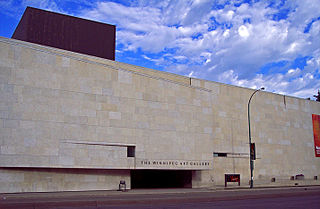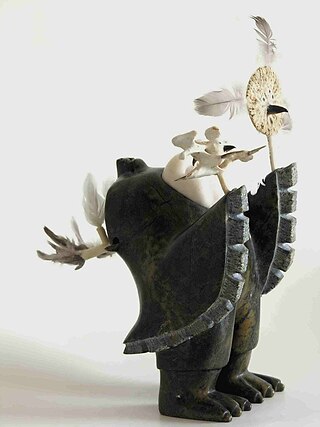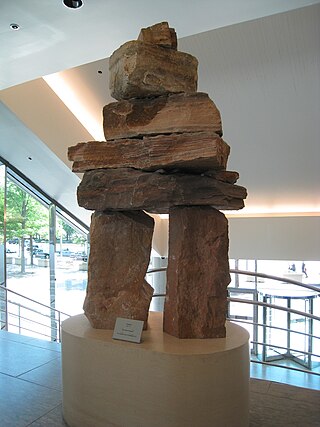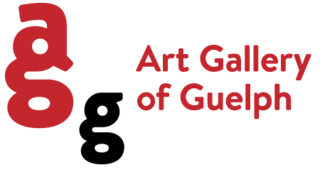
The National Gallery of Canada, located in the capital city of Ottawa, Ontario, is Canada's national art museum. The museum's building takes up 46,621 square metres (501,820 sq ft), with 12,400 square metres (133,000 sq ft) of space used for exhibiting art. It is one of the largest art museums in North America by exhibition space.

The Winnipeg Art Gallery (WAG) is an art museum in Winnipeg, Manitoba, Canada. Its permanent collection includes over 24,000 works from Canadian, Indigenous Canadian, and international artists. The museum also holds the world's largest collection of Inuit art. In addition to exhibits for its collection, the museum has organized and hosted a number of travelling arts exhibitions. Its building complex consists of a main building that includes 11,000 square metres (120,000 sq ft) of indoor space and the adjacent 3,700-square-metre (40,000 sq ft) Qaumajuq building.
The Peel Art Gallery, Museum and Archives (PAMA) is a museum, art gallery, and archives for the Regional Municipality of Peel and are located in Brampton, Ontario, Canada. Previously, it was the Peel Heritage Complex. Its facilities were originally the Peel County Courthouse, Brampton Jail, a land registry office, and a county administration building. It is opposite Gage Park and Brampton City Hall.

The McMichael Canadian Art Collection (MCAC) is an art museum in Kleinberg, Ontario, Canada. The museum is located on a 40-hectare (100-acre) property in Kleinburg, an unincorporated village in Vaughan. The property includes the museum's 7,900-square-metre (85,000 sq ft) main building, a sculpture garden, walking trails, and a cemetery for six members of the Group of Seven.

James Archibald Houston was a Canadian artist, designer, children's author and filmmaker who played an important role in the recognition of Inuit art and introduced printmaking to the Inuit. The Inuit named him Saumik, which means "the left-handed one".

Inuit art, also known as Eskimo art, refers to artwork produced by Inuit, that is, the people of the Arctic previously known as Eskimos, a term that is now often considered offensive. Historically, their preferred medium was walrus ivory, but since the establishment of southern markets for Inuit art in 1945, prints and figurative works carved in relatively soft stone such as soapstone, serpentinite, or argillite have also become popular.

Pudlo Pudlat, was a Canadian Inuit artist whose preferred medium was a combination of acrylic wash and coloured pencils. His works are in the collections of most Canadian museums. At his death in 1992, Pudlo left a body of work that included more than 4000 drawings and 200 prints.
Floyd Kuptana (1964-2021) was an Inuvialuit (Inuk) artist in Canada whose work is primarily stone carvings as well as paintings and collage.

David Ruben Piqtoukun ᑎᕕᑎ ᐱᑐᑯ ᕈᐱᐃᓐ is an Inuvialuk (Inuit) artist from Paulatuk, Northwest Territories.

The Art Gallery of Guelph (AGG), formly the Macdonald Stewart Art Center, is a public gallery and adjoining Sculpture garden in Guelph, Ontario. Its collection consists of over 9,000 works. The AGG is a nonprofit organization which focuses on research, publishing, educational programs, and touring exhibitions.
Ingo D. W. Hessel is a Canadian art historian and curator specializing in Inuit Art. The author of Inuit Art: An Introduction, Hessel has curated exhibitions for the Heard Museum in Phoenix, Arizona, the Museum of Inuit Art in Toronto, and the Art Gallery of Ontario in Toronto.
Pitaloosie Saila was a Canadian Inuk graphic artist who predominantly made drawings and lithograph prints. Saila's work often explores themes such as family, shamanism, birds, and her personal life experiences as an Inuk woman. Her work has been displayed in over 150 exhibitions nationally and internationally, such as in the acclaimed Isumavut exhibition called "The Artistic Expression of Nine Cape Dorset Women". In 2004, Pitaloosie Saila and her well-known husband and sculptor Pauta Saila were both inducted into the Royal Canadian Academy of Arts.

Ovilu (Oviloo) Tunnillie was born at Kangia, Baffin Island, Northwest Territories and was an Inuit sculptor. Her carvings served as her commentary on both traditional and changing contemporary Inuit culture. She was one of the first Inuit artists to work with an autobiographical theme.

Uqqurmiut Centre for Arts & Crafts is an arts centre that was established by the Uqqurmiut Inuit Artists Association in 1990, in Pangnirtung, in the Qikiqtaaluk Region of Nunavut, Canada. The Centre includes a Tapestry Studio, a Craft Gallery, and Print Shop. In spite of its remote location and small population, numerous Inuit from Pangnirtung have successfully marketed their prints, carvings, sculptures, and textile arts, such as woven wall hangings, to southern collectors. Starting in the 1970s, limited edition prints from the original Print Shop were published annually as the Pangnirtung Prints Collection through the then-Eskimo Co-operative. In 1970 a weaving studio was established and over time the tapestries attracted an international market.
Malaya Akulukjuk was an Inuit artist who drew works inspired by her life as a shaman and Inuit spirituality through depictions of human-animal transformations. Akulukjuk was born in 1915, and lived a traditional Inuit life in the Qikiqtat Camp of Nunavut before moving to Pangnirtung on Baffin Island in 1962. Her career as an artist started later than most, at the age of 51.
Elisapee Ishulutaq was a self-taught Inuk artist, specialising in drawing and printmaking. Ishulutaq participated in the rise of print and tapestry making in Pangnirtung and was a co-founder of the Uqqurmiut Centre for Arts & Crafts, which is both an economic and cultural mainstay in Pangnirtung. Ishulutaq was also a community elder in the town of Pangnirtung. Ishulutaq's work has been shown in numerous institutions, including the Marion Scott Gallery in Vancouver, the Winnipeg Art Gallery and the National Gallery of Canada.

Karoo Ashevak was an Inuk sculptor who lived a nomadic hunting life in the Kitikmeot Region of the central Arctic before moving into Spence Bay, Northwest Territories in 1960. His career as an artist started in 1968 by participating in a government-funded carving program. Working with the primary medium of fossilized whale bone, Ashevak created approximately 250 sculptures in his lifetime, and explored themes of shamanism and Inuit spirituality through playful depictions of human figures, angakuit (shamans), spirits, and Arctic wildlife.
Abraham Anghik Ruben is an Inuvialuit Canadian sculptor of Yup'ik descent. Ruben was born south of the hamlet of Paulatuk in the Inuvik Region east of the Mackenzie River Delta in the Northwest Territories, Canada in 1951.
Judas Ullulaq was a Canadian Inuit artist recognized for his sculpture works that are mainly figural and zoomorphic.
Ruben Komangapik is an Inuit artist primarily known for his mixed media sculptures. He is also a musician, performing both traditional Inuit drumming and singing as well as playing bass guitar in the heavy metal band Slayvz. He was born in Iqaluit, and his home community is Pond Inlet (Mittimatalik) on the high north-east coast of Baffin Island (Qikiqtaaluk).












